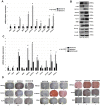LY75 Suppression in Mesenchymal Epithelial Ovarian Cancer Cells Generates a Stable Hybrid EOC Cellular Phenotype, Associated with Enhanced Tumor Initiation, Spreading and Resistance to Treatment in Orthotopic Xenograft Mouse Model
- PMID: 32679765
- PMCID: PMC7404269
- DOI: 10.3390/ijms21144992
LY75 Suppression in Mesenchymal Epithelial Ovarian Cancer Cells Generates a Stable Hybrid EOC Cellular Phenotype, Associated with Enhanced Tumor Initiation, Spreading and Resistance to Treatment in Orthotopic Xenograft Mouse Model
Abstract
The implications of the epithelial-mesenchymal transition (EMT) mechanisms in the initiation and progression of epithelial ovarian cancer (EOC) remain poorly understood. We have previously shown that suppression of the antigen receptor LY75 directs mesenchymal-epithelial transition (MET) in EOC cell lines with the mesenchymal phenotype, associated with the loss of Wnt/β-catenin signaling activity. In the present study, we used the LY75-mediated modulation of EMT in EOC cells as a model in order to investigate in vivo the specific role of EOC cells, with an epithelial (E), mesenchymal (M) or mixed epithelial plus mesenchymal (E+M) phenotype, in EOC initiation, dissemination and treatment response, following intra-bursal (IB) injections of SKOV3-M (control), SKOV3-E (Ly75KD) and a mixed population of SKOV3-E+M cells, into severe combined immunodeficiency (SCID) mice. We found that the IB-injected SKOV3-E cells displayed considerably higher metastatic potential and resistance to treatment as compared to the SKOV3-M cells, due to the acquisition of a Ly75KD-mediated hybrid phenotype and stemness characteristics. We also confirmed in vivo that the LY75 depletion directs suppression of the Wnt/β-catenin pathway in EOC cells, suggestive of a protective role of this pathway in EOC etiology. Moreover, our data raise concerns regarding the use of LY75-targeted vaccines for dendritic-cell EOC immunotherapy, due to the possible occurrence of undesirable side effects.
Keywords: Ly75; Wnt/β catenin pathway; cancer stem cells (CSCs); epithelial ovarian cancer; epithelial–mesenchymal transition (EMT); hybrid cellular phenotype; orthotopic xenograft mouse model.
Conflict of interest statement
The authors declare no conflict of interest.
Figures





Similar articles
-
LY75 Ablation Mediates Mesenchymal-Epithelial Transition (MET) in Epithelial Ovarian Cancer (EOC) Cells Associated with DNA Methylation Alterations and Suppression of the Wnt/β-Catenin Pathway.Int J Mol Sci. 2020 Mar 7;21(5):1848. doi: 10.3390/ijms21051848. Int J Mol Sci. 2020. PMID: 32156068 Free PMC article.
-
The mannose receptor LY75 (DEC205/CD205) modulates cellular phenotype and metastatic potential of ovarian cancer cells.Oncotarget. 2016 Mar 22;7(12):14125-42. doi: 10.18632/oncotarget.7288. Oncotarget. 2016. PMID: 26871602 Free PMC article.
-
Overexpression of long noncoding RNA HOXB-AS3 indicates an unfavorable prognosis and promotes tumorigenesis in epithelial ovarian cancer via Wnt/β-catenin signaling pathway.Biosci Rep. 2019 Aug 2;39(8):BSR20190906. doi: 10.1042/BSR20190906. Print 2019 Aug 30. Biosci Rep. 2019. PMID: 31337688 Free PMC article.
-
Targeting pathways contributing to epithelial-mesenchymal transition (EMT) in epithelial ovarian cancer.Curr Drug Targets. 2012 Dec;13(13):1649-53. doi: 10.2174/138945012803530044. Curr Drug Targets. 2012. PMID: 23061545 Review.
-
Role of Extracellular Vesicles in Epithelial Ovarian Cancer: A Systematic Review.Int J Mol Sci. 2020 Nov 19;21(22):8762. doi: 10.3390/ijms21228762. Int J Mol Sci. 2020. PMID: 33228245 Free PMC article.
Cited by
-
Nitidine chloride regulates cell function of bladder cancer in vitro through downregulating Lymphocyte antigen 75.Naunyn Schmiedebergs Arch Pharmacol. 2023 Sep;396(9):2071-2085. doi: 10.1007/s00210-023-02446-0. Epub 2023 Mar 14. Naunyn Schmiedebergs Arch Pharmacol. 2023. PMID: 36914902
-
New therapeutic targets and mechanisms of papillary thyroid carcinoma identified by multi-omics analysis.Discov Oncol. 2025 May 8;16(1):691. doi: 10.1007/s12672-025-02550-y. Discov Oncol. 2025. PMID: 40338406 Free PMC article.
References
MeSH terms
Substances
Grants and funding
LinkOut - more resources
Full Text Sources
Medical
Research Materials
Miscellaneous

